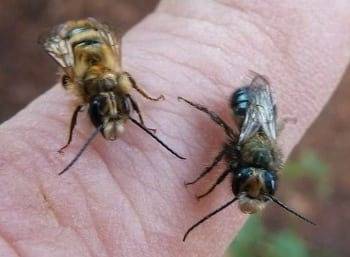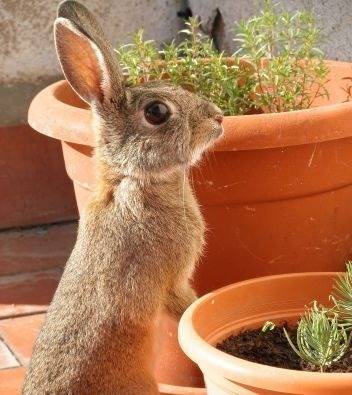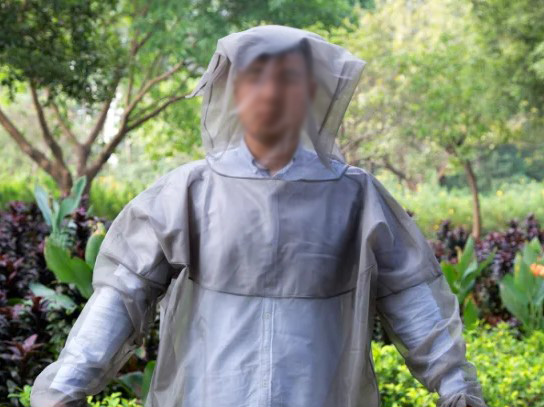Gardening certainly has evolved in recent years. Once upon a time, who cared whether we kept an arsenal of plant pharmaceuticals and fertilizers in the shed, how much water we used to keep those beds full of annuals pretty, or where our seeds or tomato plants came from? These days, it's not so easy. Before we indulge our planting passion, there are many ethical as well as health & safety dilemmas we must navigate, regarding the use of chemicals, fertilizers, and even which plants we choose. A few state and local governments have made some of those choices for us, but there are still questions that seem to have different answers, depending on who's answering.
Using Pesticides Safely to Protect Pollinators
Pesticides are products most of us would rather not use unless truly needed. But when is that? Making that determination first requires a correct diagnosis. Is it an insect, disease, or a cultural problem? Second, is the plant's health in permanent jeopardy? Many plants can tolerate some level of insect feeding or disease without a great deal of damage, although they may suffer a bit aesthetically.

Organic vs. Synthetic Insecticides
Timing of application is always important--spray in early evening when pollinators are not feeding, and avoid spraying plants in bloom. Spinosad is also slightly to moderately toxic to fish and aquatic invertebrates, moderately toxic to earthworms, and highly toxic to eastern oysters. So, we should never assume that just because something is organic that it is completely non-toxic to other wildlife. Always take care to use products carefully and appropriately, organic or not.
Systemic Insecticides: Dangers of Neonicotinoids
There is ongoing debate over one specific group of systemic pesticides--the neonicotinoids ("neonics"), as to just how toxic they are to pollinator populations, especially honeybees. Honeybees have been in decline for roughly the last 20 years, scientists citing parasites, viral pathogens, habitat loss, and increased fungicide and pesticide, especially neonic, use as likely causes. Neonicotinoids are synthetic nicotine-like chemicals that negatively affect the nervous system, lethally so for invertebrates like insects (pests and beneficials alike), and to a lesser extent for fish, birds and mammals, depending on the amount of exposure and size of the animal. They are highly water soluble, allowing them to leach into waterways, and extremely persistent, having been found to last in soil as long as three years.
Several types of neonics have been restricted in the last decade or so. In Europe, for example, three main neonics were banned for outdoor use in 2013 and all have been banned since 2018. The US Environmental Protection Agency has been evaluating the safely of neonics since 2013, with little regulation accomplished. Even a previous ban on their use in National Wildlife Refuges was overturned in 2018. While there exists a temporary halt in the approval of new neonicotinoid pesticides, the EPA has only enacted labeling requirements and restrictions related to their use (and the use of other pesticides) on agricultural crops pollinated by contracted bees, which includes numerous exceptions depending on the crop, temperature, and time of day.
But it's not just outdoor spraying that can be a problem. Neonic coated seed is commonly prophylactically used in agriculture, especially with corn, soybean, and wheat - anywhere from 50 to 100 percent of these crops in the US. Likely heavily influencing farmers' decisions is the policy of "replant coverage," whereby 100% of treated seed is covered by the producer in case of failure, while untreated seed is covered at substantially lower rates. Untreated seed for many crops is also not readily available, requiring a special order well in advance of the planting season. This despite the EPA's own analysis of numerous studies, stating there is no increased yield vs. untreated seed.
The chemical companies have long maintained that their products pose little or no threat to bee populations, using the European ban in their defense, claiming it had no effect other than costing farmers millions of dollars. Others point to lab and field studies of several types of bees, showing that neonics adversely affect their foraging behavior, reproduction, and ability to overwinter. In addition, there are studies suggesting that neonics from any source work their way up the food chain, negatively affecting birds and deer. Neonic coated seed can more directly harm both birds and humans, with songbirds dying from consuming the seeds, and human workers being affected from inhaling the neuro-toxic dust and absorbing the chemicals through the skin.
Gardeners in eleven US states don't have to worry about taking sides, since legislation has been passed regarding neonic sales and use. Most of these laws only ban the retail sale of neonics to the general consumer, however. As restricted pesticides, certified pesticide applicators may still use these products, and agricultural use is not regulated in most of these states. As of 2025, Quebec, Canada requires a "prescription" from an agronomist to prove the necessity for the use of neonic coated seed, and such seeds are banned in New York state as of July 1, 2025.
As systemics, neonics persist much longer in the plants, and have longer term effects than non-systemics. No state so far has prohibited sales of neonic-treated plants, so consumers may still be inadvertently harming bees by purchasing such plants. Neither does any law currently prevent a grower from labeling a plant grown using neonics as "bee friendly," "pollinator friendly," etc.
Avoiding Neonics to Protect Pollinators in Your Garden:
If you’ve already purchased plants and their neonic status is unknown, you can still take steps to protect desirable insect species. For pollinator plants, remove the flowers; for larval food sources (like milkweed for monarch caterpillars) cover with netting or other plant fabric for a couple of years.
If you are in a state that does not restrict retail sales of these pesticides, beware of anything marked "systemic", and avoid any with these ingredients on the label:
- Acetamiprid
- Clothianidin
- Dinotefuran
- Imidocloprid (yes, this is the same chemical that is commonly used with pets for flea and tick control in flea collars, sprays, and oral tablets. Dinotefuran may also be used)
- Thiamethoxan
You are likely to find these ingredients in major brands of products, including Bayer Advanced, Bonide, Green Light and Fertilome (even adding it to fertilizer). You may also find it in many products for grub control. Several years ago, Ortho, a Scott's/Miracle-Gro brand, removed neonics from all products labelled for outdoor use.
Reduce chemical use with IPM:
Some basic knowledge will help you along the way. The absolute best tip is to search online for your state + "cooperative extension". Almost all states will have a part of their Agriculture Department, usually working with a local university, devoted to information for home gardeners. It's free, it's provided by experts, and it applies to your local area. You''ll usually find numerous fact sheets on everything from growing vegetables and container gardening to lawn maintenance and local wildlife
Insect Control IPM Tips for the Home Garden:
- Know your conditions before you plant. A healthy plant will cope with stress much better than an improperly cultured plant. A stressed plant can easily succumb to insect feeding. Most important: know how many hours of DIRECT sun you have and how well your soil drains, and plant appropriately. Here's a link to a soil perc test you can do at home. Depending on what you're planting, your soil PH may be of importance. Often, it's to be sure that the soil is acidic enough for ericaceous plants such as rhododendrons, gardenias, blueberries, and camellias, for example. You should be able to purchase a simple test online or at your local nursery.
- Native species are often better adapted, but know your garden--planting a native rhododendron in a poorly drained spot spells disaster.
- Be forewarned about what insects your plants may be susceptible to. For example, Dwarf Alberta Spruce often turn brown from spider mite (which is mistaken for damage from a lack of water), aphids love calibrachoa, and caterpillars can destroy a crop of cabbage. Folks often notice black, sooty mold on their hollies, but the real culprit is aphids producing honeydew that the mold grows on. This is where your cooperative extension website will come in handy. Here's a list of trees, shrubs, vines, and groundcovers from Texas A&M, but it will apply to most states: Texas Insect Susceptibility List.
- Grow it right. Proper watering, and in some cases fertilizing, is essential to the health of your plants. Weakened plants are more easily damaged by pests. Watch the fertilizer, though. Feeding too much promotes a lot of young, tender, leafy growth, which is what aphids and other insects love. If you're seeing a lot of insects, consider cutting back on the nitrogen. Note also that feeding by sucking pests like aphids and scale may present with off-color, yellowing leaves that you might mistake for nitrogen deficiency. Incorrect PH can also cause the same symptoms--one more reason that a correct diagnosis is imperative before treatment.
- Regular scouting, preferably once a week. Insects usually hide UNDER leaves, so take a close look at a few of the older leaves and some of the fresh, new growth. In addition to actual insects, take note of holes, chewed leaf edges, spots, discoloration, "dirty" specks under the leaves, or sticky residue. Noticing a problem early often allows you to use gentler controls.
- Always check plants before you buy so you don't bring home a problem!
- Try a water spray. At first sign of pests such as aphids, try spraying the plant with water, hard enough to knock off the pests. Often this will be enough if done regularly.
- Don't spray or water late in the day or at night in order to prevent fungal disease.
- Many plants can tolerate a certain level of insect feeding without permanent damage, so everything doesn't always need to be treated.
- Beneficial predatory insects may be able to keep issues in check.
- Try the barrier method. For vegetable gardens, use fine mesh plant fabric or netting. These products let sunlight and water through, but keep pests out. This is almost the only way to keep away flea beetles, as they tend to feed at night and fly back to the trees during the day, and it's a great way to keep caterpillars from ruining your cabbage, broccoli, and kale crops. This method can be also used to save prized ornamentals in years with bad Japanese beetle or other pest infestations.
- When other methods have failed, the next step is a safe spray of insecticidal soap, horticultural oil, or neem oil. These are all contact insecticides, so if you miss any bugs they won't be killed. Spray under the leaves, too. Try not to spray when plants are in bloom, but if you must, avoid spraying the flowers if possible. Don't spray in full sun or in the heat of the day, and make sure the plant is adequately watered first. You may need to repeat this treatment in a week or 10 days--as always, read the label!
Note: Our recommendations are only suggestions, and may not be appropriate for your particular area. Always consult your local cooperative extension service, master gardener's program, or state natural resources department for information on what plants may be invasive in your location. Thank you!





